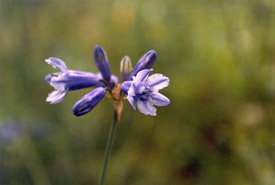
Howell's triteleia at Cowichan Garry Oak Preserve, BC (Photo by Tim Ennis/NCC)
Howell's triteleia
What does Howell’s triteleia look like?
This perennial herb has vase-like flowers that are either white or blue in colouration. The flower itself has six segments that form the vase shape that makes it a familiar member of the Lily family of plants. The plant's leaves are 20–40 centimetres long and three to eight millimetres thick. Its stalk can range from 20 to 50 centimetres tall and it spouts from a type of bulb called a “corm.” The corm is straw coloured and globe shaped and has a noticeably scaly and fibrous feel to it.
Where is Howell’s triteleia found?
Howell’s triteleia can be found in the Douglas-fir zone on the West Coast, with populations of the plant being found in both Garry oak and sand dune habitats. Both ecosystems are extremely rare and have the necessary Mediterranean climate that is required for Howell’s triteleia to survive.
Due to this limiting factor, Howell’s triteleia populations can only be found in specifics areas on BC’s west coast islands.
What is Howell’s triteleia’s conversation status?
Howell’s triteleia is currently endangered due to various factors affecting its populations. Because this plant requires specific soil and climate conditions to survive, it’s hard for the plant to expand its range further.
Another major threat to this plant is growth of the invasive species known as Scotch broom. It is particularly damaging to Howell’s triteleia as it completely outcompetes the plant and leaves no way for it to survive when Scotch broom is present in the habitat.
What is NCC doing to help protect Howell’s triteleia?
NCC is committed to protecting habitats that Howell’s triteleia thrive in, such as Garry oak habitat where NCC is doing controlled burns to manage the Scotch broom invasion. This practice is known to have a notably positive effect on the Howell’s triteleia population by removing the Scotch broom and opening the habitat for Howell’s triteleia to grow back.
Unfortunately, efforts to cross-pollinate the plant to create viable seeds have remained unsuccessful. This means that NCC must depend on the plants to self-propagate to increase their population in the face of invasive species that outcompete them. But through the hard work of the NCC team on the West Coast and our donors, NCC can help protect habitats where Howell’s triteleia is found while actively fighting encroaching invasive species.




